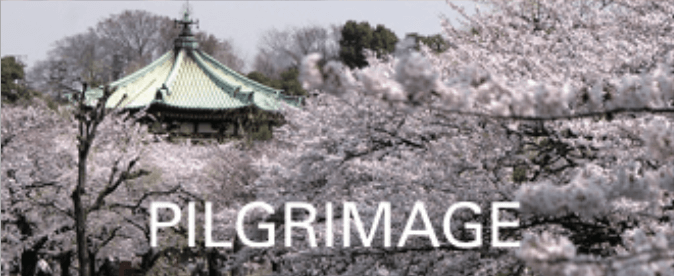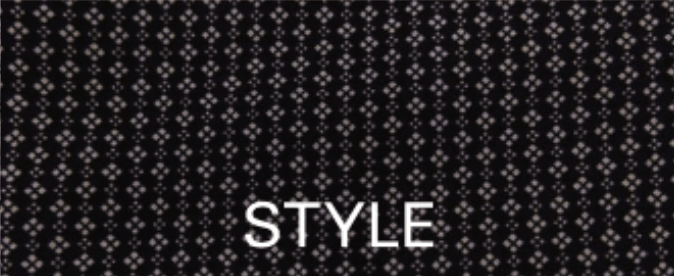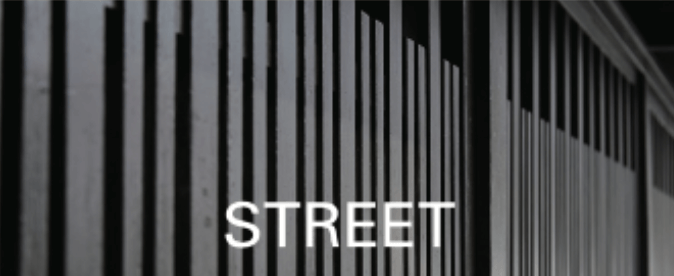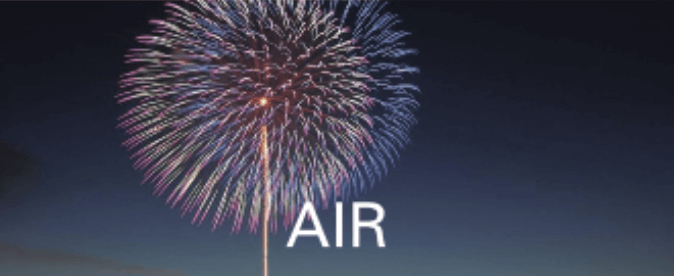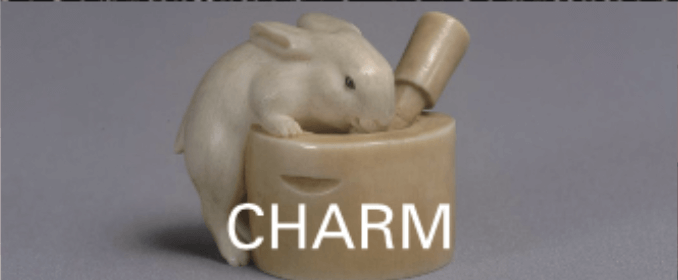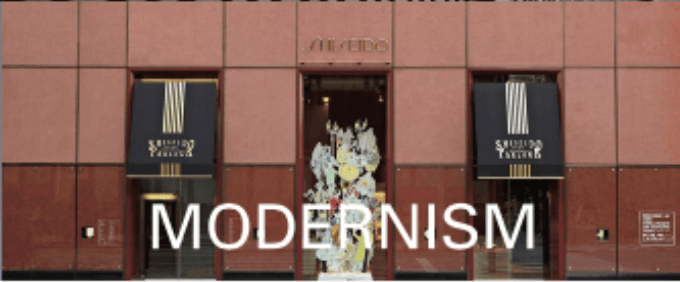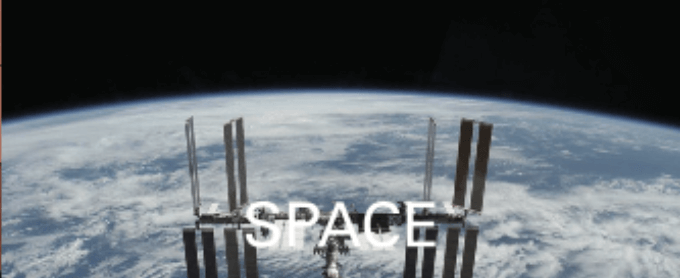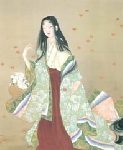
This museum exhibits works by Uemura Shoen (1875 – 1949), Uemura Shoko (1902 – 2001), the son of Shoen, and Uemura Atsushi (1933 – ), the grandson of Shoen.
There is Hanagatami, Flower basket by Uemura Shoen – Drawing Teruhinomae, a lover of Prince Oatobe (later Emperor Keitai in the 6th century) at Hanagatami, of Noh Kyogen, a farce by Zeami Motokiyo (1363 – 1443), an aesthetician, actor and Noh playwright. Shoen drew the elegant and refined insanity.
The expressions of an insane person’s face do not change like a Noh Mask. It is difficult to capture the emptiness. – A mysterious light appears in the eyes of the insane person and the line of sight turns. The person faces the emptiness as the opponent. The blossom and life are passing, and the passing is emptiness itself.
The beauty of the passage of the nature is a theme of Japanese beauty.
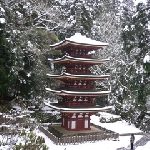
This temple was founded with an Imperial scroll written by Emperor Tenmu (631 – 686). It was built by Kenkyo (714 – 793), a priest of the Hosso sect of Buddhism, of Kofukuji Temple Nara, in the Hakuho era, during Emperor Tenmu and Empress Jito’s reign in the late of the 7th century and the beginning of the 8th century. Later, this temple was popularized as the temple of the Shingo sect, which was Nyonin Koya, a place that permitted women to worship and to practice the unobstructed cultivation of Buddhism.
This complex of temple buildings gently harmonizes with the four seasons of Mt. Murosan, where rocks in the shape of Pentagonal columns and Hexagonal columns stand upright. In particular, the five-storied pagoda built on the high stone steps next to the main temple, has Hiwadabuki, a cypress bark roof and vermilion painted bracket complexes, which creates a special atmosphere in the surrounding greenery.
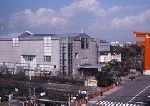
This museum is located in Okazaki-koen Park and systematically introduces works centering on the Kyoto painting circle. It shows the flow of Japanese art history from modern times to contemporary. In particular, the collection of Kawai Kanjiro (1890 – 1966), a Japanese potter, is substantial.
The museum also exhibits pottery, dyeing and weaving, and photographic works from around the world. It holds temporary exhibitions, including retrospective exhibitions of artists who greatly shaped modern art, works by overseas masters, and exhibitions that introduce trends in modern art, design, and fashion. – Kawai Kanjiro worked hard for Mingei, a Japanese folk art movement in Japan, with Yanagi Muneyoshi (1889 -1961), a Japanese art critic and philosopher.
He refused to accept the Order of Culture and he continued to work as a potter, without rank or prize, until his later years.
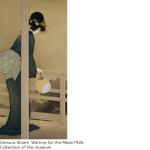
This museum, located in Okazaki Park, opened in commemoration of the enthronement ceremony of Emperor Showa (1901 – 1989) and was named as the Kyoto Enthronement Memorial Museum of Art, before World War II. The collection includes Japanese paintings, Western paintings, and craft works, from the Meiji period (1868 – 1912) to the Heisei period (1989 – 2019).
Uemura Shoen (1875 – 1949) was born in the Hajajya, a tea-leaf shop of “Chikiriya” and was cultivated in the traditional culture of Shimogyo Kyoto in the Meiji era. Shoen studied the Shijo school of formal Japanese painting, under Takeuchi Seiho (1864 – 1942). She aimed for “a picture like a serene and fragrant gem without a single vulgarity.”
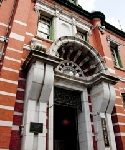
This museum is a comprehensive cultural facility that introduces well the history and culture of Kyoto. You can understand Honmamon, Genuine, in Kyoto. In addition to the various special exhibitions on the 4th floor, in the general exhibition rooms on the 2nd and 3rd floors, the museum introduces the best works related to Kyoto. In the comfortable environment of the 3rd floor film theater, masterpiece movies possessed by Kyoto Prefecture run in sequence on the screen.
And this museum is full of highlights, such as the annex (formerly the Bank of Japan, Kyoto Branch), whose modern Western-style building has been designated as an important cultural property. And the shops reproduce the townscape of latticed storefronts of Kyoto.

Maizuru City’s modernization was Red Brick Warehouses and railway construction. The warehouses were built in 1900 in the military port area, which was a private food warehouse after World War II. They are now a cultural exchange facility for citizens.
At the Maizuru City Commemoration Hall at the Red Brick Warehouses district, a dugout (canoe) about 5,300 years ago in the Jomon period (16,000 years ago – 3,000 years ago), is exhibited.
The latest Ice Age ended 10,000 years ago, and the culture south of the Yangtze River in China gradually moved north along the Kuroshio, the Japan Current. Maizuru City offers a space-time journey to the modern times and to the ancient times, too.

This temple is Daihonzan, the main temple of a Buddhist sect, which has a long history in temples of the schools of the Nichiren sect. The principal statue of this temple is a typical saint image, and was made by Inko, a high ranking sculptor of Buddhist Statues in the 14th century, which is showed by the inscription inside the statue.
Inko is also known for the statue of Ashuku Nyorai, the Imperturbable Buddha, free from anger, at Enkakuji Temple in Kakuenji, Kanagawa. It is presumed that this statue was produced at the founding of this temple and was made as a monumental statue when the schools of the Nichiren sect were officially certified in Kyoto, capital.
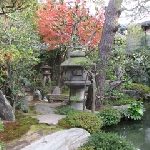
This museum is located in the former residence of Namikawa Yasuyuki (1845 – 1927), a Japanese cloisonné artist, who was highly acclaimed both in Japan and abroad during the Meiji period (1868 – 1912) and the Taisho period (1912 – 1926).
His screen composition and sense of color, were refined and created a “pause” in the small world, by putting the glaze in between tape-shaped metal wires, and repeating firing and polishing.The inside of the building is the same as it used to be.
And you can also enjoy the magnificent garden which uses the water from the Biwa Lake Canal that was drawn for the polishing the cloisonné wares. And you can feel the chastity that Namikawa loved.
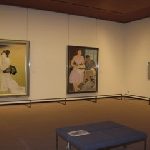
The museum is located in the Biwako Cultural Park, which is a hillock dotted with the Iron Works that supported the Yamato Court, to the east and southeast of the Seta River, in the 7th to 8th centuries. It possesses modern Japanese paintings and works related to Shiga Prefecture. Ogura Yuki (1895 – 2000) is a female Japanese painter, who drew female images in vibrant colors until the age of 105.
This museum has 60 of her works, the largest collection of her works in Japan. Her long journey is introduced in the permanent exhibition room.
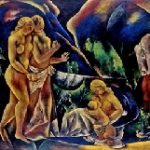
This museum stands in a green area, overlooking the castle tower of Wakayamajo Castle. It has a rich collection of modern and contemporary paintings and prints of 13,000 works.
That collection begins with Jinnaka Itoko (1860 – 1943) the first female western painter in the Meiji period (1868 – 1912). And the works of various artists associated with the local area are introduced, such as painters Ishigaki Eitaro (1893 – 1958), Kawaguchi Kigai (1892 – 1966), Nonagase Banka (1889 – 1964), Hara Katsushiro (1886 – 1964), and Murai Masanari (1905 – 1999). It also features sculptors Tatehata Taimu (1880 – 1942) and Yasuda Ryumon (1891 – 1965), and print makers Hamaguchi Yozo (1909 – 2000) and Tanaka Kyokichi (1892 – 1915).
– Jinnaka Itoko’s mother was a daughter of Goyo-eshi, a Purveying painter patronized by Wakayama Domain. She learned art education from Antonio Fontanesi (1818 – 1882), an Italian painter, who was teacher of Oyatoi Gaikokujin, the foreign employees in the Meiji Government Japan. The poetic sentiment in Japan and the reflection of traveling in Europe met.
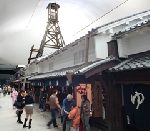
The museum’s diorama is excellent, which reproduces and displays the city of Osaka from the late Edo period (1603 – 1868) to the post World War II period. It is a full-scale reproduction of store shelves in the front of the bookstores and the publisher-store in the Edo period. New books, used books, and Ukiyoe, Japanese woodblock prints, are lined up, where you can understand the business situation at that time.
The museum also possesses valuable paintings in the Osaka painting circle, such as the paintings by Nakai Ranko (1766 – 1830), a Japanese painter who participated in the salon of writers and artists. Nakai learned the tea ceremony, studied poetry under Nakai Chikuzan (1730 – 1804), a Confucian scholar, and interacted with Kimura Kenkado (1736 – 1802), a Japanese scholar artist and art connoisseur.
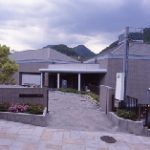
This museum introduces the oldest national highway, Takenouchi Kaido Road. The highway connects to Naniwa harbor, which was built by the order of Empress Suiko (554 – 628) during the Asuka era (592-710). The museum also shows the history of maintaining the way leading to Futakamiyama, an area rich in Sanukite, a material used in stoneware.
The museum introduces the history of the path of the Prince Shotoku (574 – 622) faith, the pilgrimage of Ise Jingu and the pilgrimage of Kannnon, the Buddhist Goddess of Mercy, to 33 temples in Kinki, western Japan. The history of the merchants’path to Yamato and Kawachi Province in Kinki is also introduced.
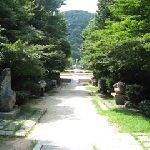
Mt. Kabutoyama erupted 12 million years ago. It is composed of andesite, which is Pyroxene. It is a completely different formation from the adjacent Mt. Rokko, which is composed of Mikage Ishi (granite). It was a sacred mountain of worship where the bronze dagger-axe was excavated. 90% of the park’s 83ha area is forest.
14 sculptures made in modern times are lined on both sides of the road to the monumental square. They look like they are worshiping this mountain as the enshrined object. This sanctuary of ancient Japan has been revived in modern ways.
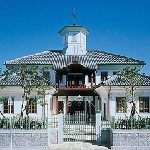
This museum is a former Hachiman Higashi Gakko (school), which was built in 1877 in Omi Hachiman City, to boast the appearance of the riverside district and merchant houses. It was restored to its original structure in 1994. The restored interior and architecture shows the dawn of modern times.
This school was opened by the donations of Omi shonin, merchants of Omi Province, who aimed to improve children’s education, after the Meiji Restoration, the event that brought back practical imperial rule of the Empire of Japan in 1868 under Emperor Meiji.
This restored building conveys the history of Omi shonin, who had refined the insight to judge the days from the Age of Provincial Wars in the 15th – 16th centuries.
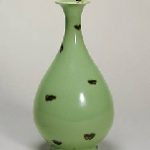
This museum possesses approximately 6,000 items, including two National Treasures, which are mainly Korean and Chinese porcelains.
The National Treasure Tobiseijihanaike – the Flower vase of Longquan celadon, with a flying iron mottle, is a masterpiece from the Yuan Dynasty (1279 – 1368), which has a flying iron mottle on the surface of the vase and was fired with celadon glaze. Its style is Gyottukoshun, the celadon vase characterized by having a thin neck, body with a bulge, and a trumpet-shaped opening.
It has a good contrast between the neck and the body and was popular in the Yuan Dynasty (1279 – 1368). Its appearance is beautiful. The glazed color is a slightly yellow celadon.
This masterpiece came from the Osaka Konoike family, Japan’s largest conglomerate in the Edo period (1603 – 1868).
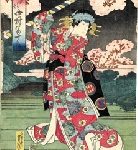
The museum displays Ukiyoe, Japanese woodblock prints produced in Osaka during the Edo period (1603 – 1868). There are Ukiyoe drawing of Nakamura Tomijuro II, who was Tayu-Onnagata, a high-ranking actor who played female roles in the Kabuki, a classical Japanese dance-drama, and was so popular in a flashy costume. The stage name of Nakamura Tomijuro was Myoseki, the famous and celebrated name succeeded by the Kabuki, in the Kabuki of Kamigata (Kyoto and Osaka area).
The handwritten Ukiyoe was born at Kamigata in the Azuchi-Momoyama period (1573 – 1603), which had been brought up by Machishu, townspeople. On the other hand, the woodblock printing Ukiyoe – Nishikie, the multi-colored woodblock printing, had spread to the common people of Edo (Tokyo), before coming to Kamigata, later. Most of the Ukiyoe prints of Kamigata are Kabuki actors’ drawings, which are realistic, including costumes with highly visible line drawings. You can feel the strength at this museum.
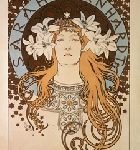
Alfons Maria Mucha (1860 – 1939), a Czech painter, illustrator and graphic artist, is a representative painter of Art Nouveau, a decorative style that emerged in Europe at the end of the 19th century. Yosano Akiko (1878 – 1942), a Japanese author, poet, and pioneering feminist, came from Sakai City. Akiko and Mucha were featured in the Magazine Myojo, a monthly literary magazine published in Japan between 1900 and 1908. This connected the two artists, who were active at the same time.
Sakai City possesses approximately 500 works of Mucha, collected by Doi Kimo (1926 – 1990), a Japanese businessman and the founder of Doi Co., Ltd., a photography business. This museum introduces a wide range of works, from the early years to the later years of Mucha from their rich collection.

Osaka was lagoon city, with over 1,600 bridges during the Taisho period (1912 – 1926). Ancient civil engineering techniques from Chinese Continents had been handed down to accommodate the Japanese climate. The name of this street came from the Sankyubashi Bridge over the Nagaborigawa River, although it has disappeared. The Sankyubashisuji Street, illuminated by restored gas lights, remains a route from Osaka City Central Public Hall to Nagahori-dori street and conveys the Taisho Roman.
– Taisho Roman is the trend of thought and cultural events in the Taisho period, which was influenced by aestheticism and Dadaism from Europe in the 19th century. This is in contrast to Taisho Modernism, which is based on Market Value.

This museum is located on the Osaka Shoin Women’s University Kosaka Campus.
Tanabe Seiko (1928 – 2019), a Japanese author, was a graduate of the predecessor Shoin Women’s College of this university. It Opened in 2007 as part of the 90th anniversary of the university. There is a literary wall with more than 260 of her book covers and magazines. The museum exhibits handwritten manuscripts edited by Tanabe when she was a student, the Akutagawa Prize (a clock) – a Japanese popular literary award, which was established in 1935 by Kan Kikuchi (1888 – 1948), a Japanese author and the founder of the monthly magazine, Bungeishunju, dresses, hats, evening bags, dolls and stuffed toys.
– Tanabe said, “It is not vulgar that a vulgar person dresses vulgarly and takes action. It is vulgar that an elegant person knows how elegant he is. On other hand, it is elegant that a vulgar person is aware of his vulgarity.”
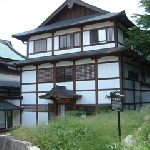
It has been said that there used to be Yunoyama Palace in Arima Kobe by Toyotomi Hideyoshi (1537 – 1598), the powerful feudal lord and Imperial Regent who unified Japan.
In the Great Hanshin-Awaji Earthquake in 1995, a part of Hideyoshi’s legendary Palace and traces of its gardens were discovered under Kuri, the kitchen of Gokurakuji Temple. The bath was a steam bath and a bathtub surrounded by rocks. Tiles and pottery, including dragon-decorated tiles were excavated, which were reminiscent of life in the palace.
This museum shows the remains of the palace inside and displays materials to show deep relations with Hideyoshi, who had restored Arima Onsen, hot spring.

This museum of Literature approaches the origin of Watsuji Tetsuro (1889 – 1960), a Japanese moral philosopher and cultural historian, who was born in Himeji. This museum displays Harima mandala, a geometric pattern that represents the history of culture in Harima Province, Hyogo.
The mandala gives an overview of the culture and climate of Harima from ancient times to the end of the Edo period (1603 – 1868), using materials and graphics on a 7m high, 60m long semicircular wall.
Along with the permanent exhibition, you can trace the origins of “a sharp and delicate intuition,” “imagination to make great strides,” and “awareness of East and West culture,” which Watsuji showed, at age 29, at the Koji Junrei – A Pilgrimage to Ancient Temples by Watsuji Tetsuro in 1919.
After he saw the reproduction of India’s Ajanta Cave at his friend house, he visited Toshodaiji Temple, Yakushiji Temple, Horyuji Temple, Chuguji Temple, in Nara and other temples near Nara, and wrote down his impressions with passion about the history of the establishment of early Buddhist art from the eastern influence of Greek culture.

The Akashi Kaikyo Bridge is the longest suspension bridge in the world. Both ancient elephants and ancients knew the time by the sun’s rays. One aspect of the modernization of civilizations was the setting of standard time in human society. The 1,084 sets of illumination lamps are installed at this bridge, too.
This bridge is close to the Japan Standard Time Meridian, which shines blue on weekdays in the summer and becomes rainbow color every hour on the hour. This bridge is a modern sundial.
– The relics of ancient elephants and ancients were founded in Akashi City, too.

This garden is in about 10 minutes by the ropeway to look down Nunobiki no Taki, which is originated Mt. Maya consisted of granite and was praised as famous mineral water by the ocean-going ship of a port of call to Kobe. This garden has about 200 species and 75,000 stumps of herbs and others and is one of the largest garden of herb in Japan. The port of Kobe opened on January 1, 1868.
Herbs were mainly introduced to Japan during the Edo period (1603 – 1868). Herbs had been cultivated in Nagasaki as appreciating plant and medicinal plant, at the time. Peppermint, sage, and chamomile were come from overseas during the Bunsei era (1818 – 1830) in the Edo period.
-The port of Nagasaki was the only opened to the ocean-going ship in
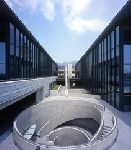
The beach of Iwaya Nada, seen from Mt. Maya was reclaimed in the modern times and became an industrial area. The museum was built to restore the richness of the heart, through art, after the Great Earthquake in 1995.
The building, like a huge labyrinth, was designed by Ando Tadao (1941 -), which is integrated with the sea, spread in front of the museum. The 8,000 item collection knows the taste of the people who endured difficulties.
Those images that believe in revival are as warm as the statue of Queen Maya, Mother of Buddha, which has been enshrined at Mt. Maya.

This public hall is in NaKanoshima, Kita-ku, Osaka City, which has a red brick wall, a bronze dome roof and Neo-Renaissance architecture. It is a beautiful building on the river bank of the Tosabori River.
The construction was completed in 1918 (Taisho 7) by the huge donation of Iwamoto Einosuke (1877 – 1916), a stockbroker in Osaka. Iwamoto was known as “a chivalrous speculator,” and died before its completion. This public hall is the place of dispatch of Osaka’s culture, where concerts, operas and lectures have been held. It is still popular as a rental hall for many people.
– This public hall is located in Nakanoshima, which had flourished with Kurayashiki, a warehouse of the Domain that was used as a rice exchange for many domains in Japan during the Edo period (1603 – 1868). Kurayashiki was shut down in the Meiji Restoration, an event that sectored practical imperial rule of the Empire of Japan in 1868 under Emperor Meiji. Nakanoshima needed redevelopment. The redevelopment needed chivalry and nobles.

This museum consists of an art department and a history department. It introduces art works and historical items, related to Ashiya. The Art department possesses mainly works by Koide Narashige (1887 – 1931), a Japanese painter, and Yoshihara Jiro (1905 – 1972), a Japanese abstract painter. Koide’s restored atelier, cafe, and beautiful lawn garden are popular. Events related to the exhibition are frequently held.
– Ashiya camera club was established in 1930, which introduced Surrealist and Avant Garde works. Photography arrived to Japan in 1860, in Yokohama Kanagawa. The culture of modernism spread with the exurban development in the Hanshin district (between Osaka and Kobe) during 1900 – 1930.
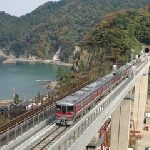
The Amarube Viaduct replaced the Amarube iron trestle-type bridge, which was the longest such bridge in Japan. The height is about 41m. The view of this viaduct as “the air train” is as beautiful as the Amarube iron bridge, which became a new symbol of Amarube.
The remaining three piers of the Amarube iron bridge have been maintained and are open to the public as an observation facility “Sora no Eki – the station in the sky”. You can reach the station by the elevator named Amarube Crystal Tower.
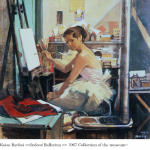
Koiso Ryohei (1903 – 1988) was the second son of the old family of the former Kuki Sanda Domaine Hyogo. He grew up in Kobe, in the atmosphere of Western-style houses lining the streets.
The civic, dignified and modern sense of his works came from his experience. Impressed by traditional European paintings, he worked hard to make Western classical techniques common in Japan. This museum introduces his art works, in the style of the port city.
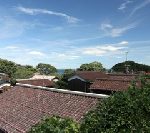
Kasa no misaki, a Cape that protrudes toward the Sea of Japan on the Kaga coast. It is a sea cliff with large and small islets scattered at the tip of the cape and a perfect scenic spot to open to the Sea of Japan to the left and right. The contrast between the chalky light house and the azure sea is beautiful.
Hashidate Town built wealth through the trade of Kitamae-bune, cargo ships that sailed the Japanese Sea, between Ezo, Hokkaido and Osaka, during the Edo period (1603 – 1868), and the Meiji period (1868 – 1912). This town was known as the wealthiest village in Japan, which was lined with the shipowners’ houses. The remnant of the wealthy village still remains.
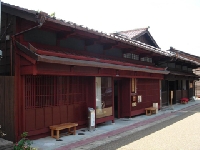
Mikuni Town had been developed by the Trade of Kitamae-bune, cargo ships, which sailed the Japan Sea between Ezo, Hokkaido and Osaka, during the Edo period (1603 – 1868). The town was supported and guarded by the Fukui Domain. The Town also developed craft techniques, such as Mikuni Tansu, a chest of drawers, which was known as Funadansu, a chest made for the protection of fragile items in the turbulent seas.
In the streetscape lined with emotional lattice doors, the former residence of the Kishina family is open to the public. It was built in 1823 by Kishina Sosuke, the owner of Shinboya, a lumber wholesaler. The power of floating lumber made the history.
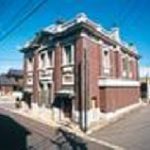
Mikuni Town is at the mouth of the Kuzuryu River that pours into the Sea of Japan. Its streetscape has an emotional atmosphere, in the contrast with the atmosphere of Tojinbo, which has dynamic scenery of cliffs and rock formations. It had flourished as a port for a long time, including the Trade of Kitamae-bune, cargo ships that sailed the Japan Sea, between Ezo, Hokkaido and Osaka, during the Edo period (1603 – 1868).
It had developed the craft techniques, such as Mikuni Tansu, a chest of drawers, which was known as Funadansu, a chest made for the protection of fragile items in the turbulent seas.
You can enjoy the streetscapes with the beauty of early modern times and modern beauty, such as houses with vermilion colored lattice doors, and the former bank’s headquarters building, with its Western-style architecture.
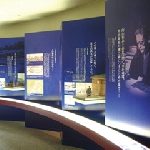
Tokuda Shuusei (1872 – 1943) was a novelist who is said to be one of the “Three Great Writers in Kanazawa,” and was active in the Meiji period (1868 – 1912), the Taisho period (1912 – 1926), and the Showa period (1926 – 1989). He was a master of naturalistic literature. – Shusei is a writer who is good at drawing women.
He described the image of the common people, by focusing on the way women live. His work is characterized by a high degree of skill which was praised as a “master of novels”, and a style closely related to the lives of the common people, which never forgets the gaze at the weaker.
This museum introduces his life and achievements and traces the origin of the warm gaze.
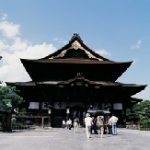
The temple has been worshiped by common people widely and deeply as the place of ties with Amida Buddha, Amitabha, the principle image of Buddha in Pure Land. The statue of Amida Buddha, Amitabha, with 3 three images in a unified halo,”Itsuko Sanzon,”is the principal work at this temple.
It arrived after passing through the Korean Peninsula in 6C. After it was abandoned by Nanba Horie, an anti-Buddhist movement, Yoshimitsu Honda from Shinano, Nagano, brought it back home and enshrined it.
This principal image has been kept hidden for more than 1300 years. The replica of this image, “Omaedachi,” was made in the Kamakura era (1192-1333) and is shown every 6 years in an event called “Gokaicho”.
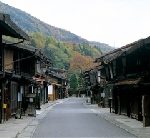
Narai is the 34th post town of Nakasendo Rokujyukyu Tsugi, Sixty-nine stops on the Nakasendo, the route connecting Kyoto and Edo in the Edo period. It has the highest altitude in Kiso Juichishuku, 11 post towns in Kiso district on Nakasendo.
The post town is next to Toriitoge Pass, which was the most difficult area to travel along the Nakasendo, and the woodwork of Magemono, a round-shaped Japanese box made of thin strips of wood, comb and lacquer ware thrived.
This post town was the western entrance to Kyoto. It was famous as Narai Senken, the thousand buildings of Narai. meaning it flourished as a post town, which was characterized by the structure of the eaves that protruded along the road.
The townscape included Hatago, inns, with Kento, lanterns hanging on its eaves. And Senbongoshi, a lattice of evenly spaced vertical timber, which provided a dignity to the town, while the arched bridge made of 300-year-old Kiso Hinoki (Japanese cypress), with no stanchions, has a deep lyricism.

Hashidate Town was known as the wealthiest village in Japan, where the shipowners’ houses were lined up. The owners built wealth through the Trade of Kitamae-bune, cargo ships sailed the Japanese Sea in between Ezo, Hokkaido and Osaka, in the the Edo period (1603 – 1868), and the Meiji period (1868 – 1912).
This museum utilized the former residence of Sakaya Chobei, who was the shipowner of Kitamae-bune. Built in 1876, this museum introduces the momentum of the history through the elaborately designed items such as Funa-Ema, a votive picture of ship, a model ship, photographs and Uchikake, a long outer robe.
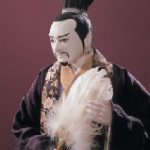
The Wakisaka family, the former lord of Awaji Sumoto Domain, became a lord of Iida Domain later. Iida has the history of the puppet theater, handed down by Myojin-ko, the fraternal religious association, which learned puppet skills from Awajishima Island in Hyogo and puppet operations in Joruri, a Japanese ballad drama with shamisen, three-stringed Japanese lute, from Osaka.
This museum was opened with puppets donated by puppet artist, Kawamoto Kihachiro (1925 – 2010). This museum exhibits puppets that appeared in the NHK TV Drama, “The Tale of the Heike”, narrative poetry of the struggle between the Taira clan and Minamoto clan for control of Japan at the end of the 12th century, and “Sangokushi”, a romance of the Three Kingdoms in the 2nd -3rd centuries in China, which consists of history, legend and myth.
You can understand that those expressive faces of puppets had been calculated well.

The movement to abolish Buddhism began after the Imperial decree promoting Buddhism by Empress Suiko (554 – 628). The gilt bronze statue of the Buddha from Baekje, Korean Peninsula was rescued from Horie Naba, Osaka and was brought to Shinano Province by Honda Yoshimitsu. Honda was from Shinano Province, saved the statue, and donated it to his home town. It was enshrined in this Temple.
The Shinhobutsu-den, a treasure hall of this temple, possesses Zakono Usu (Mortar), in which Honda Yoshimitsu enshrined and prayed to the statue, and the wood statue of Buddha Nehan, the image of the Buddha immediately after his death. This is one of only a few such statues in Japan.
This hall also introduces “Kanzan Jutoku Zu” – Portraits of Kanzan Jutoku, two eccentric monks that have been regarded as incarnations of Fugen and Monju Bosatsu, Bodhisattvas, in the Tang Dynasty period”, by Sesshu Toyo (1420 – 1506), a Zen monk and a master ink painter in Japan.
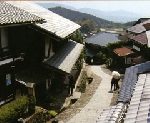
Magome post town was located between Tsumago post town, in Shinano Province Nagano and Mino Province, on the Nakasendo, the route connecting Kyoto and Edo in the Edo period. In Honjin, a lodging for a feudal lord during the Edo period, private houses, a temple and a shrine, to prepare for the commutation of alternate attendance style by feudal lords for the Edo Shogunate and the courtiers in Kyoto, in the Edo period (1603 – 1868).
Shimazaki Toson (1872 – 1943), a Japanese author, was born at this post town, where stone walls were built on both sides of street on the hill for building residences. Toson Memorial Hall is at the residence of a family that served Honjin as a wholesale dealer and village headman. Today, the courtyard still has the foundation stones of Honjin, and traces of a fireproof building.
You can see the forest of Eishouji temple, from the courtyard, which is the family temple of the Shimazaki family.
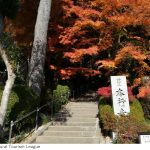
This temple is the Temple of Hokeshu, the Nichiren (1222-1282) sect of Buddhism, founded by Maruyama Baisetsu, who was the founder of the tea ceremony in Kyoto and Nanao, Ishikawa and established the golden age of Nanao Hatakeyama clan culture.
Baisetsu was of the Hatakeyama clan and born in Maruyama, Kyoto in 1471. He learned well Waka, Japanese poetry, Renka, linked verse poetry, and classical texts. He also studied pottery, Noh theater, calligraphy, and landscape. His wife was a believer of Hokeshu, and the daughter of the Yanagi family, who was Machishu, merchants and local leaders, in Kyoto and a brewer and financier. Baisetsu and his wife cooperated to introduce the culture and people to Nanao.
Hasegawa Tohaku (1539 – 1610), who was a Japanese painter and founder of the Hasegawa school, became famous and popular in Kyoto with the support of the Maruyama family.
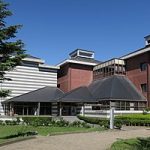
This museum opened in the Komaba Park in Nagasaki Prefecture in 1983, after the donation of more than 400 works of art collected by Yui Ichiji (1909 – 1992): a Japanese businessman and art publisher from Saku City, for 50 years, to Saku City. It possesses modern Japanese paintings, Western paintings, sculptures, crafts, and calligraphy works. The collection of the diverse works of contemporary artists are more than 3,000 items.
A porcelain panel painting, “Saku Sanka, the Hymn of Saku City – Ikeda Masuo (1934 – 1997): a Japanese painter, printmaker, illustrator and sculptor”. The panel painting is installed in front of the entrance, and is always attracting visitors.
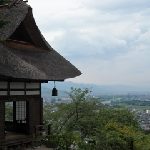
Chikuma city is a famous spot for the moon. The famous moon from Mt. Kyodaisan on the other side of the river, and “Tagoto no Tuki: the moon reflected in several rice-fields lying in tiers on a hillside”, comforted the hearts of the people, since ancient times.
The magnificent view also became a poem by Matsuo Basho (1644 – 1694), the most famous poet of the Edo period. The night view along the Chikuma River extends to Zenkoji daira, basin, under the stars in the sky. This temple faces the rice terrace of “Tagoto no Tuki” and an ancient temple of the Tendai sect.
This temple was a sacred place of Haikai, the world of Haiku, seventeen-syllable verse, loved very much by writers and artists. There are many monuments of Haiku and poems lined up in the precincts.

This museum is located on the Mikimoto Pearl Island, where the worlds first farming of semi-circular pearls began in 1893, by Kokichi Mikimoto. In 1878, Kokichi went to Tokyo on foot, saw the pearl trade in Yokohama, and became commuted to creating world class jewelry.
The museum introduces his great undertaking to realize his dream. It includes the art and crafts exhibited at the World Expo in Paris (1937) and at other EXPOs, his love of the seaside of his home town, and the history of pearl jewelry.
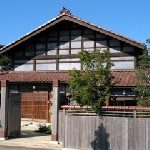
Hashidate Town was known as the wealthiest village in Japan, where the shipowners’ houses were lined up. The owners built wealth through the Trade of Kitamae-bune, cargo ships that sailed the Japanese Sea, between Ezo, Hokkaido and Osaka, during the the Edo period (1603 – 1868), and the Meiji period (1868 – 1912).
Soryokan is the part of the residence built on a small hill overlooking the sea in 1841. The Kubo family had the greatest power among the Hashidate Kitamae-bune’s owners. The Shoji, paper sliding doors of this house, is the symbol of the Japanese artisans, who had the style of intelligence, which takes in the light by dividing.
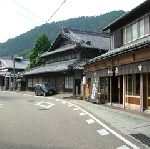
Kuwana was a key point of transportation connecting the Kinai region, provinces surrounding Kyoto and Nara and the Tosan-do Road, an ancient division of the country and the main road running through. It was situated along the central mountains of northern Honshu, Tohoku region, since ancient times.
Kuwana flourished as a relay point to Edo, to transport wood from Kiso and goods from Shogun demesne in Mino and Hida. Although the townscape at that time in Kuwan City was lost after the Isewan Typhoon in 1959, the townscape remains in Tado Town.
Tado Town has been guarded by Mt. Tadosan (Height 403 m), where people have come to pray for rain for farming and life security, since ancient times.

Kuwana, is located at the mouth of “Sansen – The three big rivers”: the Kiso River, the, Nagaragawa River and the Ibigawa River. Kuwana was run by a self-governing organization, similar to Sakai, Osaka, in the Muromachi Period (1366 – 1573).
Kuwana was a post town linked to Miyajuku Station, at Atsuta Jingu shrine, in the Edo period (1603 – 1868). Moroto Seiroku (1888 -1969), the 2nd head of the Moroto family, thrived in the wholesale business of rice, and other business in the Meiji period (1868 – 1912). He commissioned Josiah Condor to design a Western-style residence in the wooden Renaissance style.
The residence is open to the public with the appearance at the time of its construction, which consists of a group of buildings and a garden on a vast site.

The ponds, wetlands and rivers at the foot of Mt. Hakuba remain naturally intact. Artists gather there who are fascinated by the sculptural beauties of nature. They paint the wide range of mountain shapes, sculpt using mountain trees, and make accessories with driftwood flowing from the river.
Those various artistries come from the asymmetric beauty of nature. In this trial class of the craft workshop, your own sense of nature begins to breathe.
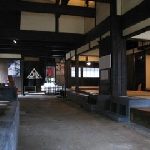
Gamo Ujisato (1556 – 1595) was a feudal lord, who was transferred from Omi Province. Ujisato built the foundation for Matsusaka’s development. By the foundation, wealthy merchants dealing in Matsuzaka cotton, opened stores in Edo, during the Edo period (1603 – 1868).
The Mitsui family opened Echigoya, a store to sell drapery, at Nihonbashi, the eastern terminus of the Nakasendo and the Tokaido, the route connecting Kyoto and Edo during the Edo period, in the Kanei era(1624~44). The Mitsui family was originally a samurai from Omi Province. Echigoya, the name of the store, came from Zuryomei, an unofficial official name given to distinguished vassals by feudal lords.
This museum is close to where the Mitsui Family started its business, and utilizes the former residence of Ozu Seizaemon, the wealthy merchant, who traded paper and cotton on a large scale in Edo, during the Edo period (1603 – 1868). This museum introduces the wealthy merchants of the Edo period.
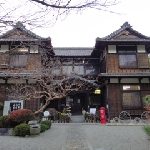
Ise Province connected the Kinai region, provinces surrounding Kyoto and Nara, with Tokai, the central Provinces and Kanto, the eastern Provinces, on Honshu Island, since ancient times.
Gamo Ujisato (1556 – 1595) was a feudal lord and was transferred from Omi Province, at the order of Toyotomi Hideyoshi (1537 – 1598), the powerful feudal lord and Imperial Regent who unified Japan, in the early modern times. Ushisato built the foundation of economic development to take advantage of the water transportation of Matsusaka, Ise Province.
Wealthy merchants dealing in Matsuzaka cotton, opened stores in Edo, during the Edo period (1603 – 1868), and seized the hearts of the snappy Edotsuko, people born and raised in Edo.
This museum displays, in an easily-understandable way, the trading of Matsusaka cotton, including the signboards written by the master calligrapher and painter in Kyoto, Ikeno Taiga (1723 – 1776).
-From April 2021, this museum starts the materials exhibition of a world-famous film director, Ozu Yasujiro (1903 – 1963), who was related with Ozu Seizaemon, the wealthy merchant, who traded paper and cotton on a large scale in Edo, during the Edo period (1603 – 1868).
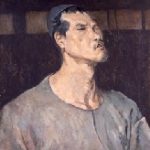
This museum has bright green filling the glass windows in the lobby entrance. The view is a masterpiece. The adjacent Shukkeien Garden is a Japanese style garden with a path around a central pond, which was created by Asano Nagaakira (1586 – 1632), the 1st lord of the Hroshima Domain. The garden contains miniature versions of a number of scenic spots in Japan. Shukkeien, in Japanese, means “reduced scenic garden.”
The museum possesses a wide range of genres of art, such as artists and works related to Hiroshima, including Aimitsu (1907 – 1946), the leading painter in Japanese modern art, Japanese and Asian craft works, including important cultural properties, and Western paintings, including Dream of Venus (1939) by Salvador Dali (1904 – 1989), a Spanish surrealist painter. You can enjoy the time of art appreciation while feeling the passage of the seasons.

There are a group of white earthen-walled storehouses, with red roof tiles and black wainscots along the Tamagawa River, flowing through the city. A stone bridge with a slight curve is laid between the storehouse and the merchant house, creating a beautiful scenery.
Yabase Ourai Kaido Road, is the road that led to Kurayoshi, since the Nara period (710 – 794), and was surveyed by Ino Tadataka (1745 – 1818), a Japanese surveyor and cartographer. This road retains the path where Tadataka walked about 200 years ago. The path is also the tradition and culture of Kurayoshi, which had flourished as a commercial city.
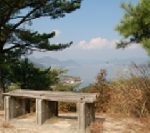
The principal image of Kojoji Temple is the statue of the Sacred Kannon, the Buddhist Goddess of Mercy. The statue was made by a Buddhist priest, Tocho Ritsushi, who traveled from the Tang Dynasty (618 – 907) and is Hibutsu, a hidden Buddhist image, ordinarily withheld from public view. The National Treasure, the vermilion three-storied pagoda, was built in the traditional Japanese-style architecture as its base. It also draws on the elements of the traditional Chinese-style architecture, which gives a strong impression with its colors and powerful engraving. The newel posts at the four corners are decorated with inverted lotus shapes, which are unique.
You can overlook Setoda Channel from Mt. Choonzan, where the tower is built. The Setoda Channel from Mt. Choonzan is the scenery that Hirayama Ikuo (1930 – 2009), a Japanese painter, overlooked in his childhood days.
Later, Hirayama painted the magnificent wall painting of “The Great Tang Dynasty of the Western Regions” at Yakushiji Temple Nara, dedicated to Genjo Sanzo (602 – 664), a Chinese monk who travelled to India and was the author of “The Great Tang Dynasty Record of the Western Regions”, and the founder of the Hosso sect of Buddhism.
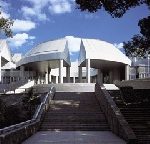
The museum opened as the first museum dedicated to contemporary art nationwide. It collects and exhibits Post-World War II art after and works related to Hiroshima City, which introduces the beauty of Hiroshima and its depth. Throughout the year, it holds special exhibitions that introduce cutting-edge expressions and exhibitions from selected works of the collection.
– The museum is located by Mt. Hijiyama, with an altitude of 71m, famous for its cherry blossoms. This mountain hill is about 1.8km at the east of ground zero of the atomic bomb, which protected the blast from spreading to the east. This museum also looks like the Temple of Apollo.
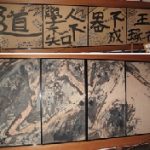
This museum uses the warehouse for raw cotton, of Kurobo Company Ltd., which was founded in 1888. The Ohara family became a leading merchant who operated cotton brokers and rice wholesalers, in Kurashiki Okayama, which was a Tokugawa Shogun demesne in the Edo period (1603 – 1868). Kobori Enshu (1579 – 1647): a feudal lord, and a master of the tea ceremony, was a local magistrate of Kurashiki, who sent a large Hyoromai, provisions of rice for the army, to the Tokugawa Shogunate in the winter campaign of the siege of Osaka in 1614.
The Ohara family moved into the spinning industry during the modernization of the Meiji period (1868 – 1912). Later, they developed an educational and social business with the establishment of hospitals, schools, and art museums. The calligraphy drawn on sliding doors for employee education in this site, by Munakata Shiko (1903 – 1975): a Japanese woodblock printmaker, is exhibited.

This museum is affiliated with the temple built by Kosanji Kozo (1891 – 1970), a monk. It was a temple where religious rites for the salvation of the departed soul of his mother could be performed.
This museum introduces valuable collections: a Mirror with a plate-rim and a design of Figures of Deities and Divine Beasts from Mochida ancient Burial Mounds during the 5th and 6th centuries, in Miyazaki. It was estimated that these were casted in the days of the Six Dynasties in China, during the 3th and 6th centuries.
It was designed as – Deities and Divine Beasts to be seen from a single angle at the top and bottom, surround Chu, finger grip in the center, and a semicircle and square pattern surround the outside of the mirror. The design symbolizes the concept of Taoist immortality.

This museum, located in Matsuyamajo Castle Horinouchi Park, collects works of Claude Monet (1840 – 1926), the French impressionist painter, and Pierre Bonnard (1867 – 1947) a French post-impressionist painter, and works of Yasuda Yukihiko (1884 – 1978), a Japanese-style historical painter and a representative of modern Japan.
The museum also introduces Sugiura Hisui (1876 – 1965), a pioneering Japanese graphic designer. Hisui studied with the Shijo school of Japanese painting, with the aim of becoming a Japanese style painter. He received guidance on painting and graphic design from Western painter Kuroda Seiki (1866 – 1924) a Japanese painter and a leader of the Western-style painting movement at the Tokyo School of Fine Art, who became a graphic designer.
Hisui’s works convey a sense of innocence, through the design of Art nouveau.
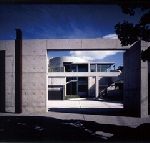
This memorial museum is built at the birthplace of Nakahara Chuuya (1907 – 1937), a Japanese poet, at Yuda Onsen, hot spring, Yamaguchi City. It exhibits valuable materials such as handwritten manuscripts, diaries, and letters by the modern poet, Nakahara Chuuya, who died at the age of 30.
You can enjoy the world of Chuya’s poetry, no matter how many times you visit, as it changes its display several times a year. Chuya left two poetry books in his lifetime and he introduced French poets, by publishing the poetry of Arthur Rimbaud (1854 – 1891), a French poet and arms dealer. He is also known as Japan’s Rimbaud.
– Rimbaud said, “Visionary power will be attained with a long-term, vast, marginal and rational confusion of all senses.” Chuya’s poems have captured the hearts of many people and are still widely loved in Japan. – The elegance of poetic unconventionality has been loved in Japan since ancient times.

You can see the most beautiful moon in Japan from this museum. Taigetsu, the mind of the waiting moon is by Okuda Genso (1912 – 2003), a Japanese painter. This museum was designed so that the moon crossing in the night sky would float on the surface of the water, after rising from the eastern mountains. It is regarded as a work of art, in order to reproduce “Taigetsu.”
Although “Genso’s Red” in his paintings is well-known, as the strong impression of the works, Okuda Sayume (1936 -), a puppet maker, created a colorful female image, as a contrast. His work, Ushio, tide, expresses a youthful feeling beyond the concept of the “doll” in blue, which is associated with the sea.
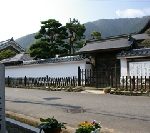
In the area of Furumachi at Ohara shuku, post town, transportation by Takasebune, flatboat through the Yoshii River had been active since the Age of Provincial Wars in the 15th – 16th centuries. After this area became Shogun demesne in the Edo period (1603 – 1868), Furumachi prospered as a collection and distribution center. Merchants’ warehouses were lined up around the docks. Daimyo Gyoretsu, the feudal lords procession for the Edo Shogunate, passed through Inaba kaido roads. These roads connected Himeji in the Seto Inland Sea, Mimasaka, and Tottori in the Japan Sea. Ohara shuku, was the only one post town in Sakushu, Mimasaka Province. Ohara shuku is also nearby Sakushu Miyamoto Village, which was the hometown of Miyamoto Musashi (1584 – 1645), a great Japanese swordsman, writer and painter.

This museum is a masterpiece of Fine art ceramic tile. The works of this museum were reproduced on ceramic tiles. The colors of works exhibited at this museum do not deteriorate over time, compared to the works of painting on paper, canvas, and clay walls.
At this museum, more than 1,000 Western masterpieces from ancient wall paintings to modern paintings were carefully selected and were reproduced in the same size as the original works that are exhibited.
You can truly enjoy the artistic value of the original picture.
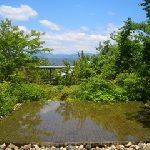
This garden was opened in 1958 to honor the achievements of Doctor Makino Tomitaro (1862 – 1957), a Japanese botanist called “Father of Japanese Botany.”
He was from Kochi Prefecture. The memorial hall opened in 1999, introducing plant illustrations by Doctor Makino. In the 8 ha. garden, you can enjoy over 3,000 species each season, including plants from Southwest Japan and plants investigated to Doctor Makino.
The restaurant and the cafe are surrounded by greenery, and the shop, full of original items, is highly recommended.
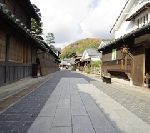
In the old townscape of Takehara, residences of wealthy merchants and merchant houses are lined up. Rai Koresuga’s Old House is a building from around 1775. He was the grandfather of Rai Sanyo (1781 – 1832), a Japanese Confucian scholar, historian and Imperialist, who supported emperor-centered nationalism at the end of the Tokugawa Shogunate period.
The basis of Confucianism is the “Ie, house” of blood relatives and family. The “Ie” was not a home where families lived together, but a place where ancestors’ spirits and souls returned. It was also thought to be a place to revive human nature.

Fumeikaku, next to the main building of Saihoji Hondo, was built in 1758, which was built in the Hosangen style, using a total of 12 columns and has the double pyramidal roof tiled in the Hongawarabuki style, a roof with formal tiles. Fumeikaku, is seen as a triangle from every direction. Its stage imitates the stage of Kiyomizudera Temple in Kyoto.
The unique roof could have been seen from anywhere in the town, and Fumeikaku could have overlooked the town of Takehara. The tea room of the houses in Takehara, have windows with views of Fumeikaku and the moon.
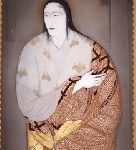
This is a temple of the Hongaji School of odo-Shin sect (True Pure Land sect), which was built by Kosanji Kozo (1891 – 1970), a monk and a businessman. A complex of temple buildings was modeled after a National Treasure building and had an attached museum. The sculptures exhibit the flow of Buddhist statues and modern sculptures from the Heian period (794 – 1185) to the Showa period (1926 – 1989).
The museum possesses paintings, including Buddhist paintings from the Kamakura period (1185 – 1333) and modern paintings. You must see the tea ceremony art. The contemporary garden, a marble garden called “Mirai no Oka,” reflects the affection of a mother with the transient beauty of Japan.
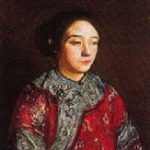
This museum is located in the Hiroshima City Central Park with lush greenery, which possesses modern European paintings centered around the French Impressionist and Japanese oil paintings since the Meiji period (1868 – 1912).
Kishida Ryusei (1891 – 1929), was influenced by Vincent van Gogh (1853 – 1890), a Dutch post-impressionist painter, and Paul Cezanne (1893 – 1906), a French Post-Impressionism painter, who resonated with the ideals of humanitarianism in the Shirakaba school, a literary society that emphasized humanitarianism, and deeply expressed “the inner beauty”.
He looked at the problems of the modern Japanese painting that drastically pursued the art of Western Industrialized countries.
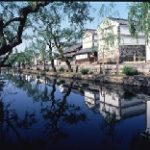
Kobori Enshu (1579 – 1647), a feudal lord, a master of the tea ceremony, an architect and garden designer, was a local magistrate of Bichu Matsuyama Domain and Kurashiki, during the winter campaign of the siege of Osaka in 1614.
Enshua sent a large Hyoromai, provisions of rice for the army, to the Tokugawa Shogunate side. After the campaign, Kurashiki became a Shogun demesne, in 1642, and flourished as the commercial place, where rice, cotton, and oil from Bichu, Mimasaka, Sanuki Provice, was gathered and transported via land and waterways.
Warehouses for cotton, rice and manure wholesalers were built along the river, and the Ohara family became a leading merchant who operated cotton brokers and rice wholesalers.
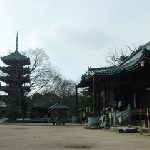
This temple is located on the banks of Shido Bay, where the water is beautiful and the legend of Amas, a female diver and a male diver remains. This temple was founded in the Nara period (710 – 794). It is said that this temple was the family temple built by Fujiwara no Fuhito (659 – 720), a powerful member of the Imperial court, to perform religious rites for the salvation of the departed soul of Fuhito’s mother. Fuhito’s mother is said to be Ama.
The highlights of this temple are: 1) Niomon, Deva gate, which was built by the Matsudaira family, the feudal lord of Takamatsu Domain in 1670, and is one of Japan’s three most famous gates using Mitsumune Zukuri, a three ridge construction. There are roofs in front of and behind the gate and a large roof is placed on top of those. – 2) the Statues of Kongo Rikishi, a pair of guardians of a temple. There is Agyo, an open-mouthed statue and Ungyo, a closed mouthed statue, said to be made in the Kamakura period (1185 – 1333) by Unkei (1150 – 1223), a Japanese sculptor of the Kei school. – 3) and Karesansui, a dry landscape garden, designed by Shigemori Mirei (1896 – 1975), a modern landscape architect.
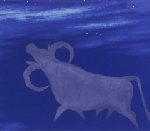
Zentsuji City is the birthplace of Kobo Daishi Kukai (774 – 835), the founder of the Shingon sect of Buddhism, and there is Zentsuji temple related to Kukai. The museum exhibits works also related to Kukai.
There is a memorial hall for Onishi Tadao (1918 – 2007), a lacquer artist who was born and grew up in the City. Onishi used the technique of carved lacquer and created vases, pitchers, Kogo, an incense container, and wares. He made folding screens, pictures of carved lacquer and architectural decorations.
And Onishi left the picture of carved lacquer, ”Mao no Sato the 75th Zentsuji Temple” (of Shikoku Reijo, 88 temples of Shikoku’s holy spots), which has the theme of Saeki Mao – the real name of Kobo Daishi Kukai, before he became Buddhist.
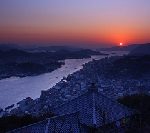
The observatory at Mt. Jodojiyama has the best view in Onomichi City, which overlooks the Seto Inland Sea and sometimes the distant Shikoku Mountains can be seen. This temple is at the foot of the mountain, which is said to have been founded by the Prince Shotoku (574 – 622). It enshrines the statue of an eleven-faced Kannon, the Buddhist Goddess of Mercy.
The scene in the evening sun from this observatory is truly the scene of Pure Land. It is this Buddhism that was transmitted to Japan that provided its dependents with the sentiment of the pathos in the Japanese archipelago, which continues to pass, with nature and climate.
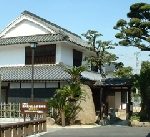
In 1878, Isozaki Minki (1834 – 1908): a Japanese textile weaver and inventor, completed the “Kinkanen (figured mat)”, known to the world with its name, by the weaving machine and method to make accurate and elaborate mats from rushes of Okayama specialty.
This museum used to be a residence and work place for Minki. A slope was placed in the building for loading and unloading of goods and pulleys were set up in the atrium of the earth floor. The entrance is opened and closed by turning and sliding, and the windows on the second floor have shutters protruding outside.
Devices and Efficiency by individual effort, are the style of the Meiji period (1868 – 1912).
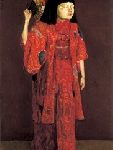
This museum has representatives of Western European art from the Barbizon school, Impressionism to the present day, and a group of masterpieces that cannot be overlooked in the history of Japanese modern art after the Meiji period (1868 – 1912). Little Girl Dancing by Kishida Ryusei (1891 – 1929) was a Portrait of Kishida’s eldest daughter, 9 years old. Kishida was born in Ginza Tokyo, joined Hakuba-kai, a group of Japanese western painters who held exhibitions of their works, and studied under Kuroda Seiki (1866 – 1924), a Japanese painter and a leader of the Western-style painting movement. Kishida got acquainted with Yanagi Muneyoshi (1889 -1961), a Japanese art critic, philosopher and founder of the Mingei (a Japanese folk art movement in Japan), and Mushanokoji Saneatsu (1883 – 1976), a Japanese novelist, poet and philosopher. He was also influenced by Albrecht Durer (1471 – 1528), a German painter in the renaissance period, and changed to his painting style rigorous and realistic. In his later years, he was enthusiastic about collecting oriental antique art and Kabuki, a classical Japanese dance-drama. In “Little Girl Dancing,” you can see the influence of Ukiyoe, Japanese woodblock prints, the Edo period (1603 – 1868).

There is Jogyo-do, a hall for Nenbutsu, a religious practice of chanting the text of the hope for rebirth in Pure Land. The principal image is the wood standing statue of Amida, Amitabha, the principal image of Buddha in Pure Land. This statue was made using Yosegi zukuri, the technique of assembling wood blocks, after they were treated and carved. The entire statue is made of cypress wood, covered in gold leaf on Japanese lacquer, and has Gyokugan, eyes made of inlaid crystals. This statue is a standing statue, with a stole draped on both shoulders, which makes Raigo-in, a symbolic gesture with the fingers welcoming the Pure Land.
This statue has ink writing at the doweling of the sole of the foot, which is inscribed “Kosho Hogen Kaikei Kenreki Gannen Sangatsu Niju Hachi Nichi.” It is signed on March 28, 1221, by Kaikei, The Master and the second highest rank in the hierarchy of Buddhist priests. It shows that this statue was made in 1221 by a sculptor of great Buddhist images. Kaikei was from the Kei school during the Kamakura period (1185 – 1333). Documents stored inside the statue were found, which explained the circumstances for Kaikei to decide to make this statue.
The standing statue of Amida began with Kaikei for the first time in the world.
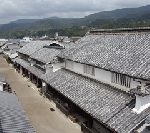
Hachisuka Awa Domain encouraged indigo plantations for Osaka and the Kinai region, provinces surrounding Kyoto and Nara, during the Edo period (1603 – 1868). Merchants of indigo and kimono, Japanese traditional clothes, developed and prospered in this area, which was blessed with the water transport of the Yoshino River.
The prosperity remains in the streetscape here. It features the eaves of the large tiled roofs along the line of houses and the walls of thick plaster and plaster-finished Udatsu, lavishly decorated short pillars set on a beam to support a ridgepole. These were symbols of wealth and success.
In life here, local production in business and decorative arts were not divided.

This temple was founded by Gyoki (668 – 749), a Japanese Buddhist priest, and organizer of public works projects, like irrigation, by the Imperial scroll of Emperor Shoumu (701 – 756), in the Tempyo era (729 – 749) of the Nara period (710 – 794).
Kobo Daishi Kukai (774 – 835), the founder of the Shingon sect, stayed and practiced at this temple, for the foundation of the Shikoku Reijo, the 88 temples of Shikoku as holy sports.
It is said that during his stay here, Kukai realized the landscape of this mountain overlapped the scenery of Mt. Ryojusen in India, where Buddha had preached his teaching. Naruto was the gateway to Shikoku Islands from the Kinai region, provinces surrounding Kyoto and Nara, since ancient times.
Kukai had designated this temple as the first place of Shikoku Reijo.
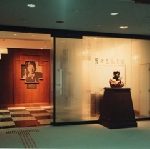
Kan Kikuchi (1888 – 1948), a Japanese author and the founder of the monthly magazine, Bungeishunju, had the anecdote of reading through most of the 20,000 books in Takamatsu’s library when he was a student. He laid the foundation for the rise of the present literary world. The museum opened in 1992 to present and introduce his long-term achievements and honors. You can trace Kikuchi’s life through the reproduction of his study room, including photographs of his life, handwritten manuscripts, numerous relics and actual materials. Successive winners of the Akutagawa Prize and the Naoki Prize
– Japanese popular literary award, which he established in 1935, are also introduced and displayed to show the flow of Japanese literature. Kikuchi founded the monthly magazine, Bungeishunju for young writers. He set an expensive clock as the main prize for the Akutagawa Prize, so that the young writers could bring it to a pawn shop, if they needed to.
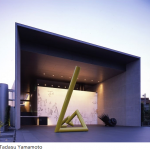
Inokuma Genichiro (1902 – 1993), a Japanese figurative artist and abstract painter, was born in Kagawa Prefecture. In Tokyo, he studied under Fujishima Takeji (1867 – 1943), a Japanese painter, and in Paris, he studied under Henri Matisse (1869 – 1954), a French painter. After World War II, he was based in New York and Hawaii, and he interacted with Jasper Johns (1930 -), an American painter, and Isamu Noguchi (1904 – 1988), a Japanese American artist and landscape architect.
This museum is “Ekimae Art Museum – a museum in front of the railroad station” that is unique in Japan. It possesses approximately 20,000 works of Inokuma and introduces them in the permanent exhibition, as well as holding temporary exhibitions and workshops on contemporary art.
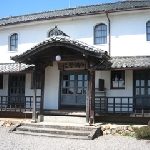
Sashi Shuzan (1829 – 1896), opened a private school of Chinese classics in Unomachi Town, Seiyo City for 11 years from 1858. He sparked the enthusiasm of education for the townspeople and was the model for the Chinese classics teacher in the novel “Botchan”, by Soseki Natsume (1867 – 1916): a Japanese novelist. Natsume is best known around the world for his novel Botchan, whose theme is morality.
The story is based on the author’s personal experience as a teacher dispatched to Matsuyama Ehime. Shingi-do was the predecessor of Kaimei Gakko, which was built by his disciples and students of Shuzan. More than 90 hanging wall charts used for textbooks in the Meiji period (1868 – 1912), are stored at this school and are considered across Japan as valuable materials.
It shows that the education system of Terakoya: a private elementary school in the Edo period (1603 – 1868), achieved greatness.
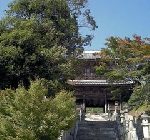
This temple is Okunoin, an Inner sanctuary, of Kotohiragu Shrine, in Kohira Town Kagawa. It tells the history of Shinbutsu-shugo, the syncretism of Shintoism and Buddhism. Goma, a fire ritual, takes place in the main temple and Goma-do Hall and on the all the glorious grounds of Hashikura Prefectural Natural Park.
You can visit this temple at the top of Mt. Hashikura (Height 600 m) by the ropeway from the foot of the mountain in about 4 minutes. You can see the Yoshino River, nicknamed Shikoku Saburo, below you. You can see the magnificent mountain, Mt. Tsurugi with the Shikoku Mountains in front of you.
“Hashi”-kuyo, a memorial service of Chopstick is held in August.

This museum is located on Omishima Island, which is the central part of the Shimanami Kaido, a 60 km long toll road that connects Japan’s main island of Honshu to the island of Shikoku, passing over six small islands in the Seto Inland Sea. You can see the flow of modern Japanese painting from the latter half of the the Showa period (1926 – 1989).
The Memorial Exhibition Room of Tabuchi Toshio (1941 -) was made to commemorate the 10th anniversary of the museum’s opening. The Exhibition Room exhibits his works and also drawings where his emotion in the production process were recorded. Tabuchi said, “The real thing is only what is in front of you. No one can draw the real thing from a picture”. – Tabuchi said that this is time’s real witness.
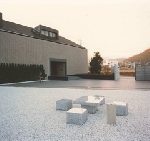
The museum’s collection includes paintings of Japanese artists who were active in Japan and overseas since the Meiji period (1868 – 1912). Artists include: Kuroda Seiki (1866 – 1924), a Japanese painter and a leader of the Western-style painting movement, Fujishima Takeji (1867 – 1943), and Fujita Tsuguharu (1886 – 1968), a Japanese-French painter. Also featured are paintings of unique painters, such as Nakamura Tsune (1887 – 1924), Matsumoto Shunsuke (1912 – 1948), and Noda Hideo (1908 – 1939).
There are also paintings of artists overseas, such as Eugene Henri Paul Gauguin (1848 – 1903), a French Post-Impressionism painter, Pablo Picasso (1881 – 1973), a Spanish artist who lived in France, Georges Rouault (1871 – 1958), a French Fauvist painter, and Maurice Utrillo (1883 – 1955), a French painter.
Lastly, you can see paintings of the artists from Imabari City, such as Noma Hitone (1901 – 1979). So, you can see the broad transition of modern Western paintings.
– Noma Hitone lived during the century of war. He painted with a humorous and fantastic style, using brilliant colors and bold brushstrokes. This is the climate of Imabari.
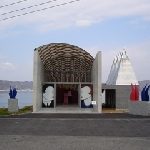
This museum of contemporary sculpture is located at the point where you can see the beauty of the islands of the Seto Inland Sea. It exhibits approximately 30 pieces of 3D work such as Noe Katz (1953 -), a Mexican Postwar & Contemporary artist, who is active in the USA, Marisol Escobar (1930 – 2016), a French sculptor, Tom Wesselman (1931 – 2004), an American artist associated with the Pop Art movement, Giacomo Manzu (1908 – 1991), an Italian sculptor, who created the “Death Gate” at St. Peter’s Basilica Cathedral over 14 years, Hayashi Norichika (1948 – ), a Japanese wood sculptor, Fukai Takashi (1951 – ), a Japanese sculptor, and Ikeda Munehiro (1939 – ), a Japanese sculptor and print maker. It stands out in a landscape like architecture.
– Ikeda Munehiro studied Romanesque art (10th – 12th centuries) en route to a pilgrimage to Spain. There are museums hosteling the mind including this museum in the Shimanami Kaido, a 60 km long toll road that connects Japan’s main island of Honshu to the island of Shikoku, passing over six small islands in the Seto Inland Sea. The Shimanami Kaido is also the art of the pilgrimage in Japan.
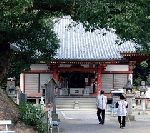
This temple is the 69th temple of Shikoku Reijo, the 88 temples of Shikoku as holy spots, and enshrine the 74cm-long statue of Nehan, the image of the Buddha immediately after his death. The face of the Reclining Buddha was made in Shiraki Yosegi Zukuri, the technique of assembling wood blocks, after being treated and carved, made of white wood with the grain of a board. This is one of the few examples in Japan that show the image of Nehan, in sculpture.
A cute little statue of the Fujiwara era of Kokufu Bunka, Japan’s original national culture (894 – 1185), has a gentle and graceful appearance, which lays on the right side with his head facing north, under Sarasoju, a sal tree, and with its legs overlapped. This statue conveys the moment when Buddha entered Nehan in loneliness.
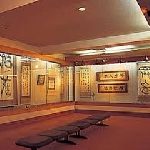
This museum introduces well the essence of Aki culture, with calligraphy. The Goto clan, the chamberlain of the Tosa Domain, founded Heii Gakusha, the school for the retainers of the Domain, and encouraged reading and writing to the common people. After, many Terakoya, a private elementary school in the Edo period (1603 – 1868), were established. That social infrastructure produced many excellent calligraphers.
These great calligraphers like Kawakita Ouun (1874 – 1954), his younger brother, Kawatani Shotei (1886 – 1933) from Kawakita Village and Teshima Yukei (1901 – 1987) came out in the Meiji period (1868 – 1912).
Teshima Yukei founded Shousho, calligraphic style, which was a fusion of oriental spirituality and modern sensibility. It gained an international reputation.
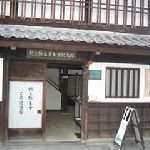
Nogami Yaeko (1885 – 1985), a Japanese author, was born here in 1885. She sought women’s independence, while cooperating with Seito, the Blue Stocking Journal, a literary magazine, created in 1911, to promote the equal rights of women through literature and education.
This museum preserves her real oral words along with about 200 handwritten manuscripts and relics of her teenage years. In September 1978, she was selected as the No. 1 Honorary Citizen of Usuki City and was active in writing until 99 years old.
And “The Alps Girl in the Mountains” by Johanna Spyri, a Swiss author in 1881, was the first translated by Yaeko, which is now famous as “Heidi, Girl of the Alps”. The Japanese Anime TV series of Hidi, Girl of the Alps is a based on the novel by Johanna Spyri, which was so popular in Japan, too.
Yaeko is a women and author who lived by her own philosophy.
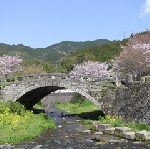
Meganebashi, a two-arched bridge at Akizuki, Asakura City was built in 1810. The historic Akizuki Castle Town dates back to 1203, with the Akizuki clan, who is said to be the descendant of the Chinese Emperor of the Han Dynasty. The Akizuki clan had moved to Takanabe, Miyazaki, after the conquest of Toyotomi Hideyoshi (1537 – 1598), the powerful feudal lord and Imperial Regent who unified Japan.
Even after the Akizuki clan moved out, Akizuki Castle Town was maintained well by the branch Domain of Kuroda Domain, Fukuoka, who was passed on the insight from Akizuki clan. This castle town was mentioned as a little Kyoto, with the tasteful townscape.
It conveys the history that the beauty of insight had been cultivated here as centered on the clan school, Keikokan.

This museum exhibits the materials related to China and Portugal, associated with Nagasaki, excavated archaeological materials, and the cultural materials of Dejima, a Dutch trading post located in Nagasaki, from 1641 to 1854. This museum introduces the history of Nagasaki, which developed as the only gateway to foreign countries in the Edo period (1603 – 1868).
This museum introduces the depth of Nagasaki taste, through food culture such as Shipoku Ryori, Japanese-Chinese cuisine, which is the cuisine of Ozashiki, withdrawing room, formal cuisine in Nagasaki, and dolls loved by children and adults.
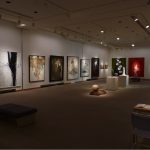
This museum adjacent to Maizuru Park, Takanabe, holds an exhibition related to Miyazaki and possesses Calligraphic works of Akizuki Tanetatsu (1833 – 1904), the son of the 9th lord of the Takanabe domain, Akizuki Tanetada, as a town museum of art.
This museum introduces a Series of painting “Suijyo”, objects on the water, by Shimizu Seisaku (1943-), who came from Miyazaki. He draws people in the horizontal layout, with including sacred and evil characters. He develops the highly decorative beauty with the composition style.
There was a clan school, Meirindo, at the Takanabe Domain in the Edo period (1603 – 1868), where the retainers, farmers and common people could study the Analects of Confucius, calligraphy and mathematics. The beauty of Takanabe Twon is endorsed by intelligence and knowledge rooted locally.
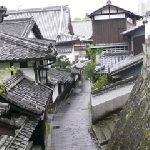
Usuki had prospered as a castle town until the Meiji Restoration, in 1868: event that sectored practical imperial rule of the Empire of Japan under Emperor Meiji. Nioza is the district where a lot of ruins of samurai residences, with large gate and white-walled fireproof buildings, stand in a row. The Stone pavement is in harmony with the white plaster walls on the stone walls.
This district was originally a tuff hill, made of the volcanic ash of Mt. Aso. The rocks were shaved and the roads passed through. Those are called Kiritoshi, street cut through hilly terrain. Kiritoshi, in front of Kyu Shinkoji, a former Shinkoji temple, is a representative scene of Usuki.
You take a breath in its appearance.
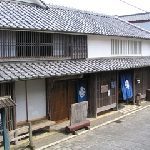
Mimitsu became the commercial port of Takanabe Domain in the Edo period (1603 – 1868) in the early modern times. Sengoku Bune, a large junk boat with capacity for 1,000 koku, a unit of volume of rice, arrived in Mimitsu, loaded with wood transported through the Mimikawa River, and headed to Osaka.
A number of houses and stores of shipping agencies and traders lined up, until the Meiji Restoration, an event that sectored practical imperial rule of the Empire of Japan in 1868 under Emperor Meiji.
This museum is the house of former Kawachiya, shipping agency and trader, which has wide frontage, Kyogoshi, a thinner lattice of Kyoto townhouses, and white walls, and can overlook the port of Mimitsu from the second floor.
This museum exhibits Funadansu, a chest made for the protection of fragile items in the turbulence of rough seas, and boat furniture, which conveys the prosperity and the atmosphere at that time.
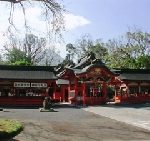
This shrine boasts a 1,300 year history of watching the sea of Satsuma Kagoshima, as a guardian of sailing, traffic and fisheries, from the northern foot of Mt. Kaimondake. This vermillion shrine building is elegant and the Kohai-bashira, the pillar of the roof over its steps, is carved with Dragons in the clouds.
This treasure hall possesses the National designated cultural property, Matsuume makie kushige, a gold-lacquered toiletries case with pine and cherry blossom, the frame from Ryukyu Kingdom and old documents related to the Shimazu clan, the feudal lord of the Satsuma Domain, which connected the dynasty cultures of the Heian, Kyoto with those of Ryukyu, Okinawa.
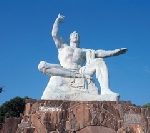
Heiwakinenzo, the statue is for holding funerals for victims of the atomic bomb and praying for global peace. This statue expresses power and youth, by Kitamura Seibo (1884 – 1987), the Recipient of the Order of Culture, who came from Shimabara City Nagasaki Prefecture and wished for peace. This statue is a bronze statue completed on August 8, 1955. It is 9.8m tall, stands on a 3.8m pedestal, and weighs approximately 22t.
This statue symbolizes the love of God and the mercy of the Buddha. The Buddha’s right hand is pointing to heaven, showing the past “threat of the atomic bomb”, while its left hand extends horizontally, showing the future of “peace”. And the lightly closed eyelids show the present “holding funerals for victims”

Mimitsu has the legend of Jinmu Tosei, the Eastern expedition of the first Emperor Jimnu, who departed from Mifune, which became the commercial port of Takanabe Domain in the Edo period (1603 – 1868), in the early modern times. Sengoku Bune, a large junk boat with capacity for 1,000 koku, a unit of volume of rice, arrived in Mimitsu, loaded with wood transported through the Mimikawa River, and headed to Osaka.
It is said that a number of houses and stores of shipping agencies and traders lined up. It was called Mimitsu Senken, Mimitsu of 1,000 buildings means a flourishing town, until the Meiji Restoration, an event that sectored practical imperial rule of the Empire of Japan in 1868, under Emperor Meiji.
The townscape still remains tasteful and traditional, where Kyogoshi, a thinner lattice of Kyoto townhouses, and white walls, stand in a row.

Sotomemachi Nagasaki is located at Nishisonogi Peninsula northwest of Nagasaki City and is 50 km before the Goto Islands, over the west coast of Sumo-nada Sea. The scenery is a model of the novel “Silence” by Endo Shuusaku (1923 – 1996), a Japanese author.
– Endo wrote as a Japanese Roman Catholic. “Silence” – Rodrigo, an Italian Jesuit priest arrived in Goto Islands in Japan in the 17th century to find the priest renounced his faith, under the decree of the prohibition on Christianity. He was betrayed by Kichijiro, who was an alcoholic fisherman renouncing his Catholic faith, and was imprisoned with many Japanese converts. Eventually Rodrigo heard the voice, after a long silence. And he recognized that “Who can say that the weaker did not suffer more than the stronger?”
This museum is built with the monument that is engraved “Even though humans are so sad, Lord, the sea is so azure”. This museum captured the sea view of Sotomemachi in various places, which Endo described as a landscape to look back on his life alone. The underground Christians used to stay in Sotomemachi and moved to Goto Islands from here during the Edo period (1603 – 1868).

Toshio (1749-1835) was born in Tamana Kumamoto and was a famous monk who studied at Enryakuji Temple at Mt. Hiei, Siga and excelled in calligraphy and painting. The paintings are mainly Buddhist paintings and Zen paintings. The calligraphy is his original style. This calligraphy is work he did in his 60’s, which expresses the power especially in his works.
This museum possesses and exhibits the collection of Imanishi Kikumatsu (1913 – 1987), a former NHK Kumamoto broadcasting stationer, after returning from Siberia, where he was a prisoners of war after World War II.
